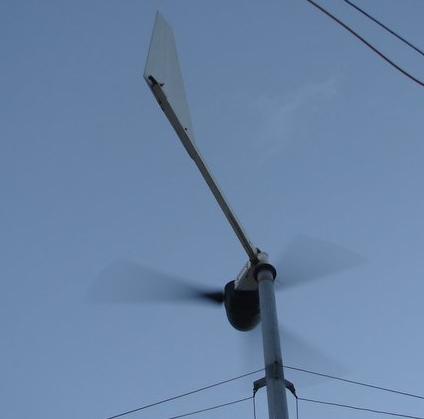| Author |
Message |
greengoblin
Newbie

Joined: 03/03/2009
Location: AustraliaPosts: 14 |
| Posted: 01:55am 29 Mar 2009 |
 Copy link to clipboard Copy link to clipboard |
 Print this post |
|
Gday everyone, i am a virgin to this great site so please bear with me. I have lived for the past 15 years not connected to the grid, using hydro and solar power. This windpower is new to me, as is the f&p motor so i built an exercise bike using a f&p motor, modified according to instructions gathered here. I did this to check output of the motor, which is now a generator and also get an idea of the input needed to produce x amount of power. It works very well! I am now building a wind generator but am puzzled why i need to furl the turbine. Forgive my ignorance but my turbine will have 6 blades at 1 mtr each, this is a hi torque, low speed design according to what i have read here, so even in high winds, should be ok. The other factor i have noticed on my bike is that as i pedal faster, the resistance increases dramatically as the amps go up, as would be expected! So both of these influences would make the turbine self regulating (i'm guessing), so why would i need a furling tail? Thank you.....Pete |
| |
DaViD

Senior Member

Joined: 14/01/2009
Location: United StatesPosts: 120 |
| Posted: 04:39am 29 Mar 2009 |
 Copy link to clipboard Copy link to clipboard |
 Print this post |
|
Hi Pete, leg power compared to wind gusts during a storm is like
comparing leg power to a bulldozer. At some point the wind will always
get the upper hand 
If your not living on the edge your taking up to much space! |
| |
KiwiJohn
Guru

Joined: 01/12/2005
Location: New ZealandPosts: 691 |
| Posted: 09:52am 29 Mar 2009 |
 Copy link to clipboard Copy link to clipboard |
 Print this post |
|
Gidday Pete, with my experiments with a F&P on an exercycle I reduced the stator somewhat (sawed off about 60% of the coils) which allowed my pedal effort to turn it much faster than otherwise.
I found that by pedalling, really, really hard and fast I could get to a point where the resistance from the F&P appeared to not increase anymore and might have even fallen away a bit. I assume that occured at a speed where the alternator went out of its efficiency band.
Presumably if a wind turbine got up to that speed in a strong wind there would no long be anything to stop the mill racing to destructive speeds. |
| |
GWatPE

Senior Member

Joined: 01/09/2006
Location: AustraliaPosts: 2127 |
| Posted: 11:51am 29 Mar 2009 |
 Copy link to clipboard Copy link to clipboard |
 Print this post |
|
The power that inductance limiting on a F&P restricts output power to is approx 300W for a single stator. With series caps and modified loading the upper limit I have personally measured at just under around 900W max on a windmill. This was with late furling as well. I now limit to approx half this amount with furling. High rpm will allow above 1kW from a single stator in other applications. [not sure for how long].
Gordon.
become more energy aware |
| |
greengoblin
Newbie

Joined: 03/03/2009
Location: AustraliaPosts: 14 |
| Posted: 12:58pm 29 Mar 2009 |
 Copy link to clipboard Copy link to clipboard |
 Print this post |
|
Thanks for the replies, very imformative and helpful. Guess i had better build a pivot for that tail! |
| |
MacGyver

Guru

Joined: 12/05/2009
Location: United StatesPosts: 1329 |
| Posted: 02:54am 15 May 2009 |
 Copy link to clipboard Copy link to clipboard |
 Print this post |
|
If you are able to find a close-up picture of a Jacobs Wind Electric
generator, you'll notice fly-weights attached to a pitch modulating
mechanism.
Depending on how you build your blades and especially if they are
flexible (like PVC) the weights can be placed in such a position as to
either "feather" or "spoil" the pitch when the thing moves towards over-
speeding. Centripetal force acting on the whirling weights places angular
momentum on each one's anchorage in the blade edge.
My windmill(s) pump air and I put an isolation ball valve on each one for
that purpose. If a gale pops up, the valves are closed (manually) and the
thing spins only until it cannot overcome the resistance presented by the
dead-head of compressed air inside and it stops.
I've never "launched" any blades and have been building these things for
40 years. My blades, by the way, are constructed of solid, flat, aircraft-
quality aluminum stock. Reynolds numbers; who needs them? I never
found the time to make things that complicated.
Nothing difficult is ever easy!
Perhaps better stated in the words of Morgan Freeman,
"Where there is no struggle, there is no progress!"
Copeville, Texas |
| |

